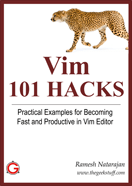VMware Server runs on top of an existing host operating system (Linux or Windows) as shown below. This is a quick way to get started with the VMware. Refer to our VMware introduction article to get a high level understanding on virtualization fundamentals.

1. Download VMware Server 2
Go to VMware Server download page . VMware Server 2 is free. But, you should register on VMware website to get the license key.
On the download page following download options are available. In my case, I downloaded the binary .rpm format.
- VMware Server 2 for Windows Operating Systems – Binary .exe format
- VMware Server 2 for Linux Operating Systems – Binary .gz format
- VMware Server 2 for Linux Operating Systems – Binary .rpm format
2. Install VMware Server 2
Install the VMware Server 2.0.2 rpm as shown below.
# rpm -ivh VMware-server-2.0.2-203138.i386.rpm Preparing... ########################################### [100%] 1:VMware-server ########################################### [100%] The installation of VMware Server 2.0.2 for Linux completed successfully. You can decide to remove this software from your system at any time by invoking the following command: "rpm -e VMware-server". Before running VMware Server for the first time, you need to configure it for your running kernel by invoking the following command: "/usr/bin/vmware-config.pl". Enjoy, --the VMware team
3. Configure VMware Server 2 using vmware-config.pl
Execute the vmware-config.pl as shown below. Make sure to enter the appropriate serial number that you got from vmware website.
Accept default values for everything. Partial output of the vmware-config.pl is shown below.
# /usr/bin/vmware-config.pl Do you accept? (yes/no) yes Do you want networking for your virtual machines? (yes/no/help) [yes] Please specify a name for this network. [Bridged] Your computer has multiple ethernet network interfaces available: eth0, eth1. Which one do you want to bridge to vmnet0? [eth0] Do you want to be able to use NAT networking in your virtual machines? (yes/no) [yes] Please specify a name for this network. [NAT] Do you want this program to probe for an unused private subnet? (yes/no/help) [yes] Do you wish to configure another NAT network? (yes/no) [no] Do you want to be able to use host-only networking in your virtual machines? [yes] Please specify a name for this network. [HostOnly] Do you want this program to probe for an unused private subnet? (yes/no/help [yes] Do you wish to configure another host-only network? (yes/no) [no] Please specify a port for remote connections to use [902] Please specify a port for standard http connections to use [8222] Please specify a port for secure http (https) connections to use [8333] The current administrative user for VMware Server is ''. Would you like to specify a different administrator? [no] Using root as the VMware Server administrator. In which directory do you want to keep your virtual machine files? [/var/lib/vmware/Virtual Machines] Please enter your 20-character serial number. Type XXXXX-XXXXX-XXXXX-XXXXX or 'Enter' to cancel: AAAAA-BBBBB-CCCCC-DDDDD Starting VMware services: Virtual machine monitor [ OK ] Virtual machine communication interface [ OK ] VM communication interface socket family: [ OK ] Virtual ethernet [ OK ] Bridged networking on /dev/vmnet0 [ OK ] Host-only networking on /dev/vmnet1 (background) [ OK ] DHCP server on /dev/vmnet1 [ OK ] Host-only networking on /dev/vmnet8 (background) [ OK ] DHCP server on /dev/vmnet8 [ OK ] NAT service on /dev/vmnet8 [ OK ] VMware Server Authentication Daemon (background) [ OK ] Shared Memory Available [ OK ] Starting VMware management services: VMware Server Host Agent (background) [ OK ] VMware Virtual Infrastructure Web Access Starting VMware autostart virtual machines: Virtual machines [ OK ] The configuration of VMware Server 2.0.2 build-203138 for Linux for this running kernel completed successfully.
4. Go to VMware Infrastructure Webaccess
As part of the vmware-config.pl, it starts all the required VMware services and also adds to the start-up script. To verify whether all the VMware scripts starts appropriately during start-up, reboot the server.
Go to https://{host-os-ip}:8333/ui to access the VMware Infrastructure web access console. This will prompt for the login and password as shown below. LoginName is root. Password is host OS root password.
 Fig: VMware Web Access Login
Fig: VMware Web Access Login
In the upcoming article, we’ll discuss on how to create virtual machine using the inftrastructure webaccess.






 My name is Ramesh Natarajan. I will be posting instruction guides, how-to, troubleshooting tips and tricks on Linux, database, hardware, security and web. My focus is to write articles that will either teach you or help you resolve a problem. Read more about
My name is Ramesh Natarajan. I will be posting instruction guides, how-to, troubleshooting tips and tricks on Linux, database, hardware, security and web. My focus is to write articles that will either teach you or help you resolve a problem. Read more about
Comments on this entry are closed.
Yet another great article from Ramesh. You could have expanded a bit on port(s) to which this server is listening or/and just briefly note how virtual machines are created with vmware before you leave the details for the next article.
This is a nice guide, but I’m sorry to report that VMWare Server has reached “End of Availability” per VMWare:
http://www.vmware.com/support/policies/lifecycle/general/index.html#policy_server
By default VMWare server appears to run it’s RAM from hard disk space which kills performance. To stop it – add the following to /etc/vmware/config:
tmpDirectory = “/tmp/vmware”
mainMem.useNamedFile = “FALSE”
sched.mem.pshare.enable = “FALSE”
MemTrimRate = “0”
MemAllowAutoScaleDown = “FALSE”
Then create /tmp/vmware and add an FSTAB entry like so:
tmpfs /tmp/vmware tmpfs rw,size=5120M 0 0
This creates some tmpfs for the RAM to run from that is actually run from RAM meaning a huge performance improvement.